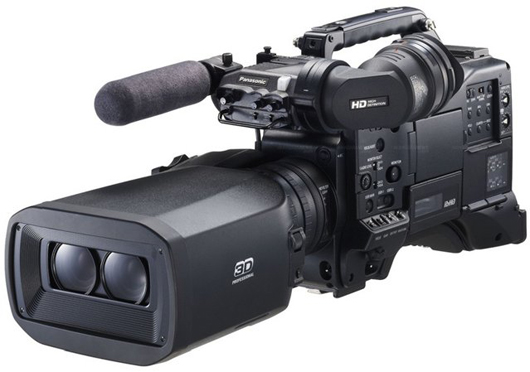Stereo 3D Meets P2 AVC-Intra Recording in a Next-Gen Shoulder Mount
The camera will feature two P2 card slots that must be occupied; for 3D the left and right eye data streams will be recorded to separate cards; for 2D capture the base (left) view will be recorded redundantly to both cards. An interesting setup, but also one that precludes continuous-run operation, when the two cards are full, the camera must be stopped to replace the cards.
The camcorder will support a range of frame rates and resolutions at 720p, 1080i and 1080p, including adjustable frame rates at 720p up to 60 FPS, a compelling feature for shooters who understand the value of tweaking frame rates for capturing sports and wildlife, or to add emphasis in a chase scene for example. The 3DP1 will also be a global camera with 50/60Hz support and nominal frame rates of 24, 25, 30 and 60 FPS for a range of Web, Blu-ray and DVD applications. Recording to 2 X 64GB cards in native mode the camera will record continuously up to 150 minutes at 24pN or 120 minutes at 30pN. Interestingly the record time per card varies at 720p depending on the frame rate; at 1080i, capturing images at 50 or 60 fields per second, the record time does not vary with frame rate.
More Options for Small-Screen Display
With a zoom range of 17X and a 35mm equivalent wide-angle the camera will prove more versatile than the 3DA1 for most users, allowing more practical setups in the critical six to eight foot (1.5m – 2.5m) range. Like its predecessor, the 3DP1 features an orthostereoscopic perspective with a fixed 58mm interaxial (slightly narrower than the 3DA1) preserving proper object roundness at "normal" shooting distances from a human perspective. The 58mm IA is especially conducive to a small-screen display, such as a laptop or tablet, which will no doubt gain prominence in the very near future for training, online education and other non-theatrical 3D applications. The 3DP1's minimum convergence setting of approximately 1.1 meters will represent a 48% improvement over the A1's 2.1m minimum, a valuable consideration for routine setups and interviews.
Designed around two HPX370 camcorders the twin-lens 1/3-inch stereo sensor block is solidly mounted as a single unit with a mechanical toe-in. This means the P1 will operate in a wider range of shooting environments, including helicopters and certain aircraft, that were previously off-limits to the 3DA1, given that model's floating lens block and sensor design.
In addition to being about two stops more sensitive than the A1, the new camera will offer a built-in optical neutral density filter – thank you – with 2-stop, 4-stop, and 6-stop attenuation. The camera will retain the intervalometer. Audio will be captured at 16-bits through 4-channels, with a wireless mic receiver slot provided in the camera body.
3D Assist Gets a Boost
The hottest new feature, however, in the 3DP1 will likely be the 3D assist functions. With the 3D assist enabled, the viewfinder and swing-out LCD screen display a three-tier color scheme: objects approaching too close inside the pre-defined comfort zone are rendered in RED; objects positioned too far from the pre-defined comfort zone are rendered in YELLOW; objects at the screen plane display in GREEN. The assist parameters are user-settable from 0.5% to 4.0% in positive and negative space, providing a critical tool for camera operators and producers obligated to respect the stringent requirements of most broadcasters. Keep in mind the 3DP1 is a native 1920 X 1080 camera; like the A1 model it will not allow horizontal re-positioning (translation) in post without resizing and loss of resolution. This places the burden therefore on the camera operator or control facility to establish the appropriate convergence during original image capture. Also, note that the optional color VF will be necessary to take advantage of the advanced 3D color-assist tools.
The camcorder's 3D assist will extend beyond the color-code display. Linked to the 17X zoom, the camera's 3D MODE will restrict the zoom range to prevent excessive divergence at longer focal lengths. Accommodating different screen sizes the zoom range will be limited to 7X when set to NEAR or NORMAL; when set to EXTENDED, the zoom can reach its maximum 17X range, the equivalent of 590mm in 35mm SLR format. It does this, by the way, while compensating for any vertical disparity that may be introduced at the higher magnification. Wow!
In Summary
Compared to its more modest AG-3DA1 predecessor the new AG-3DP1 will be considerably more rugged. The front nose retaining cap is now easily removable for adding supplemental Proxar lenses or screw-in type filters; the magnesium chassis of the camera extending forward to provide substantial support (possibly) for a lightweight clip-on matte box. Since the P1 will contain built-in neutral density, many users may not feel the need for an external filter holder. In any case it would be nice if Panasonic saw fit to include a basic lens shade, the problems associated with off-axis light directly striking the front of the dual lenses being especially critical in 3D.













Leave a Reply